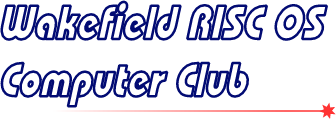Meeting: The Toolbox for Beginners
Steve Potts guided us through the process of writing simple desktop RISC OS applications using AppBasic and the Toolbox. As small teams, those present started from scratch to copy a utility that Steve had devised. By the end of the evening everyone present had a working piece of software – some with features that Steve hadn’t even thought of!
Reports by Derek Baron and Terry Marsh
Discovering AppBASIC
By Derek Baron
I have felt inspired to write my first report of a meeting after enjoying this one so much. After a recent let down by an invited speaker, what a contrast. Steve Potts had gone to great lengths to carefully prepare for this meeting. After distributing those with programming knowledge in the four groups around the available computers, which in the event proved unnecessary, Steve gave a short introduction to Toolbox programming before sitting in the middle of the room at his own computer connected to the screen which we were all facing. We all had a well constructed full-colour worksheet to hand, which again was unnecessary as Steve carefully guided us through the steps to initiate our first Toolbox program. I have said the worksheet was unnecessary but it is now an invaluable reminder when it comes to the real test of trying this at home.
Gradually as we constructed our first window – a copy of one Steve put on the screen – and became familiar with the various gadgets you could feel the atmosphere in the room changing as everybody became more involved. Steve showed us all the useful help available through the StongHelp files so that we could choose the relevant procedure name to include in our own program by a click on the mouse. We were constructing a simple logic program so the programming was easy to follow, but again Steve was making sure that we had to understand no more than two lines at a time. It all seemed so painless, everybody understood the need to go back to the window editor to find out the number of each of the gadgets we had used so as to be able to assign a variable name with the number for the gadget.
At last we were ready to test our program: you could feel the tension. I don’t think any of the groups were successful first time but here was a surprise. An error window opened up in the editor which by a double-click brought up the relevant line for correction. All the errors were typing mistakes, usually because of the long mixed case procedure names. The debugging certainly got the room animated and soon everybody was elated that “their” program worked.
I certainly learned a lot about Toolbox programming: Steve managed, seemingly effortlessly, to push us a fair distance up the learning curve. My next computer task is to update my version of Zap so that I can use the extremely useful throwback system and then try some experiments with Toolbox.
Many thanks to Steve Potts for all the work he must have done to give us all this rewarding experience.
A Non-Programmer’s View
By Terry Marsh
After setting up the tables and computers in the meeting room as to the drawing Steve sent to the committee previous to the meeting, we arranged a maze of power lines to each table and a spur to the sound system table. Steve Potts then loaded the programs needed from a memory stick to each of the computers: a Cube, two A6s, another PC with Virtual Acorn, and Steve’s laptop by the projector at the rear so as to observe the four computers and the members being instructed.
Steve had already sorted the members out in the room as to their abilities, ie: anyone who had programming skills or had an understanding of BASIC. Then he spread them out among the tables, so no one table was at a loss. He also placed on each table some copies of three instruction sheets stapled together, one for each member sat at the table.
We then followed Steve’s instructions, and followed the sheets provided to construct the mini-program, with any problems sorted out quite efficiently by Steve or one of the members at the table – even though our table’s computer wanted to finish downloading an upgrade to Windows every 10 minutes.
Everybody completed the task in hand and the evening was very interesting, especially for members who weren’t sure about dabbling in the black art of programming. I think a lot found it not quite as hard to write a program for our computers with the help of AppBASIC.
I for one thought Steve did an excellent job of very professionally sorting out the glitches that occurred, and making everything run seamlessly.
Meeting resources
There are more resources for this meeting if you are a WROCC member: log in to view them.







